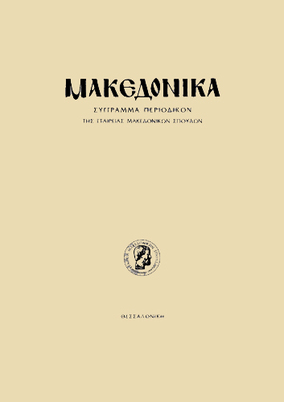Το εικονογραφικό θέμα Άνω σε εν θρόνω και κάτω εν τάφω
Part of : Μακεδονικά ; Vol.33, 2002, pages 217-241
Issue:
Pages:
217-241
Parallel Title:
The iconographie theme “Enthroned Above, Entombed Below”
Section Title:
Articles
Abstract:
The troparion Enthroned above, entombed below, the heavens and infer nal regions comprehending, O my Saviour, are shaken by Thy death, for be yond all understanding Thou wert seen dead and with the life that was in the beginning, is sung at Matins on Holy Saturday. The text of this short hymn, which has been attributed to Brother Mark, Bishop of Hydrus (Otranto), has a multi-layered theological content, expressing both the identification of the earthly (dead) Christ with the Eternal Word and the paradox of His death: Christ lies dead in the tomb and at the same time is seated on His heavenly throne. The first visual representation of this hymn appears to date from the late Palaeologan period (in the chapel of the Vlatades monastery), while the oldest representation dated by inscription (1483/84) is found in the church of St John at Cucer, near Skopje. From that time onwards and until the middle of the 18th century the motif was widely used, particularly in monastery churches. The iconography of the theme, with Christ portrayed in glory in the upper part of the composition and in a sarcophagus within a rock sepulchre, em bodies a literal visual rendering of the hymn. The lower part of the compo sition is connected with a series of Late Byzantine representations inscribed with the title Epitaphios and showing Christ lying wrapped in grave-clothes in a sarcophagus. In these scenes the sarcophagus is surmounted by a vaulted canopy from which hang three lamps. The upper part of the composition is eschatological in character. Like the representations of the Man of Sorrows entitled The King of Glory and the embroidered epitaphions displaying the dead Christ with the symbols of the Evangelists and the heavenly hosts, they underline the identity of the Suffering Christ with the Word that was in the beginning, and reveal in an eschatological dimension the power of the Suffering Christ over life and death, in accordance with the Holy Saturday hymns. One fixed element in the iconography of the motif is the presence of the prophets Jacob and Isaiah, although they were not included in the two earliest representations of this subject. The first time they appear in a representation of this specific theme is in the katholikon of the Athonite monastery of Koutloumousiou (1540), although they had earlier been depicted flanking the Man of Sorrows in the Anapafsas Monastery (1527).It was also in this period that the position of the Enthroned above scene in the iconographie programme of the sanctuary became fixed. In the katholikon of the Dionysiou Monastery (1547), it is already associated with the semi dome of the prothesis. One critical factor in the development of the scene and its positioning on the altar in the Late Byzantine period was the Hesychastic attribution of significance to the church and its several parts, while the culmination during the 16th century of the formalisation and theological foundation of the hymnology of Holy Saturday upon the preparation for the distribution of the elements that takes place at the “table of oblation” con tributed to the final positioning of the motif in this part of the sanctuary. An other contributing factor appears to have been contemporary theological disputation relating to the consequences of the Passion of Christ upon the Holy Communion. The iconographie theme of the Enthroned above is not simply a visual rendering of the fact of the Lord’s burial, but an apocalyptic vision of the cessation through the Passion of the work of divine Providence and its redeeming consequences. It is a reminder of the eternal Sabbatarianism of the heavenly Church Triumphant; and it was this aspect of its content that was given expression in the monastic foundations.
Subject:
Notes:
856:https://ejournals.epublishing.ekt.gr/index.php/makedonika/article/view/5847, DOI: https://doi.org/10.12681/makedonika.286
Electronic Resources:




